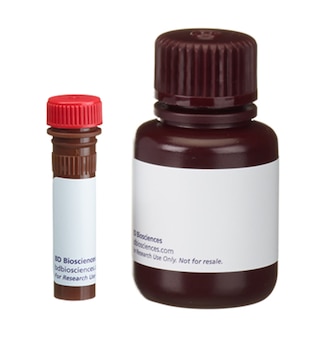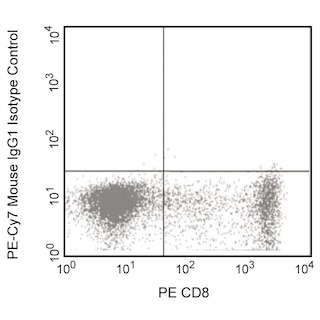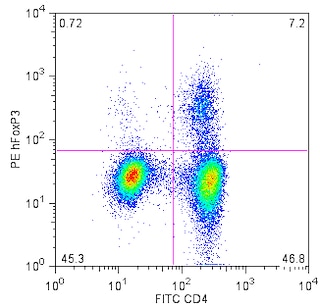Old Browser
Looks like you're visiting us from {countryName}.
Would you like to stay on the current country site or be switched to your country?
BD Pharmingen™ Human Regulatory T Cell Cocktail
(RUO)


Three-color analysis of the expression of CD4, CD25, and CD127 on peripheral blood mononuclear cells (PBMCs). PBMCs were stained with either PE-Cy™7 Mouse IgG1 ĸ Isotype Control (Cat. No. 557872/555909: data not shown) or Human Regulatory T Cell Cocktail (Cat. No. 560249). The PBMCs were then fixed, lysed and permeabilized using BD Pharmingen™ Human FoxP3 Buffer Set (Cat. No. 560098) and stained with PE conjugated anti-human FoxP3 monoclonal antibody (Cat. No.560082). During data analysis, lymphocytes were identified by light scatter profile and CD4 positive expression. The figure on the left represents the CD25 and CD127 expression profile of the CD4 postive cells. The panel on the right shows hFoxP3 expression on CD127dim/CD25bright T regulatory cells (solid line) and other T cells (dashed line). Flow cytometry was performed on a BD FACSCanto™.

BD Pharmingen™ Human Regulatory T Cell Cocktail
Regulatory Status Legend
Any use of products other than the permitted use without the express written authorization of Becton, Dickinson and Company is strictly prohibited.
Description
The Human Regulatory T cell cocktail is a three color reagent used to identify the natural T regulatory cell (nTreg) population. An expression pattern of CD4+CD25int/brightCD127dim closely correlates to the expression of the transcription factor Forkhead box P3 (FoxP3). FoxP3 is considered a specific marker to T regulatory cells (Tregs). The SK3 antibody recognizes CD4, an antigen expressed primarily on helper/inducer T lymphocytes, although this antigen is also present in low density on monocytes. The 2A3 antibody recognizes CD25, an antigen also known as the human low-affinity interleukin-2 receptor (IL-2R). The CD25 antigen is present on a subset of peripheral blood lymphocytes. Antigen density increases on phytohemagglutinin (PHA)-, concanavalin A (Con A)-, and CD3-activated T lymphocytes; T lymphocytes from mixed lymphocyte cultures; and human T-lymphocyte leukemia virus (HTLV)-infected T-lymphocyte leukemia lines. HIL-7R-M21 reacts with the 60 - 90 kDa glycoprotein, CD127. CD127 is also known as the IL-7 receptor alpha (IL-7Rα). The receptor is a heterodimer composed of the CD127 and the common gamma chain, shared by other cytokine receptors (IL-2R, IL-4R, IL-9R, and IL-15R). CD127 is expressed on thymocytes, T- and B-cell progenitors, mature T cells, and some lymphoid and myeloid cells.
Preparation And Storage
Recommended Assay Procedures
BD® CompBeads can be used as surrogates to assess fluorescence spillover (compensation). When fluorochrome conjugated antibodies are bound to BD® CompBeads, they have spectral properties very similar to cells. However, for some fluorochromes there can be small differences in spectral emissions compared to cells, resulting in spillover values that differ when compared to biological controls. It is strongly recommended that when using a reagent for the first time, users compare the spillover on cell and BD® CompBeads to ensure that BD® CompBeads are appropriate for your specific cellular application.
Product Notices
- This reagent has been pre-diluted for use at the recommended Volume per Test. We typically use 1 × 10^6 cells in a 100-µl experimental sample (a test).
- An isotype control should be used at the same concentration as the antibody of interest.
- Source of all serum proteins is from USDA inspected abattoirs located in the United States.
- Caution: Sodium azide yields highly toxic hydrazoic acid under acidic conditions. Dilute azide compounds in running water before discarding to avoid accumulation of potentially explosive deposits in plumbing.
- Warning: Some APC-Cy7 and PE-Cy7 conjugates show changes in their emission spectrum with prolonged exposure to formaldehyde. If you are unable to analyze fixed samples within four hours, we recommend that you use BD™ Stabilizing Fixative (Cat. No. 338036).
- For fluorochrome spectra and suitable instrument settings, please refer to our Multicolor Flow Cytometry web page at www.bdbiosciences.com/colors.
- PE-Cy7 is a tandem fluorochrome composed of R-phycoerythrin (PE), which is excited by 488-nm light and serves as an energy donor, coupled to the cyanine dye Cy7, which acts as an energy acceptor and fluoresces maximally at 780 nm. PE-Cy7 tandem fluorochrome emission is collected in a detector for fluorescence wavelengths of 750 nm and higher. Although every effort is made to minimize the lot-to-lot variation in the efficiency of the fluorochrome energy transfer, differences in the residual emission from PE may be observed. Therefore, we recommend that individual compensation controls be performed for every PE-Cy7 conjugate. PE-Cy7 is optimized for use with a single argon ion laser emitting 488-nm light, and there is no significant overlap between PE-Cy7 and FITC emission spectra. When using dual-laser cytometers, which may directly excite both PE and Cy7, we recommend the use of cross-beam compensation during data acquisition or software compensation during data analysis.
- Cy is a trademark of GE Healthcare.
- The Alexa Fluor®, Pacific Blue™, and Cascade Blue® dye antibody conjugates in this product are sold under license from Molecular Probes, Inc. for research use only, excluding use in combination with microarrays, or as analyte specific reagents. The Alexa Fluor® dyes (except for Alexa Fluor® 430), Pacific Blue™ dye, and Cascade Blue® dye are covered by pending and issued patents.
- Alexa Fluor® 647 fluorochrome emission is collected at the same instrument settings as for allophycocyanin (APC).
- Please refer to www.bdbiosciences.com/us/s/resources for technical protocols.
- Please refer to http://regdocs.bd.com to access safety data sheets (SDS).
- Cy is a trademark of Global Life Sciences Solutions Germany GmbH or an affiliate doing business as Cytiva.
- This product is provided under an intellectual property license between Life Technologies Corporation and BD Businesses. The purchase of this product conveys to the buyer the non-transferable right to use the purchased amount of the product and components of the product in research conducted by the buyer (whether the buyer is an academic or for-profit entity). The buyer cannot sell or otherwise transfer (a) this product (b) its components or (c) materials made using this product or its components to a third party or otherwise use this product or its components or materials made using this product or its components for Commercial Purposes. Commercial Purposes means any activity by a party for consideration and may include, but is not limited to: (1) use of the product or its components in manufacturing; (2) use of the product or its components to provide a service, information, or data; (3) use of the product or its components for therapeutic, diagnostic or prophylactic purposes; or (4) resale of the product or its components, whether or not such product or its components are resold for use in research. For information on purchasing a license to this product for any other use, contact Life Technologies Corporation, Cell Analysis Business Unit Business Development, 29851 Willow Creek Road, Eugene, OR 97402, USA, Tel: (541) 465-8300. Fax: (541) 335-0504.
- Alexa Fluor™ is a trademark of Life Technologies Corporation.
- Please observe the following precautions: Absorption of visible light can significantly alter the energy transfer occurring in any tandem fluorochrome conjugate; therefore, we recommend that special precautions be taken (such as wrapping vials, tubes, or racks in aluminum foil) to prevent exposure of conjugated reagents, including cells stained with those reagents, to room illumination.
Companion Products




| Description | Clone | Isotype | EntrezGene ID |
|---|---|---|---|
| PE-Cy7 Mouse anti-Human CD25 | 2A3 | IgG1, κ | N/A |
| FITC Mouse anti-Human CD4 | SK3 | IgG1, κ | N/A |
| Alexa Fluor™ 647 Mouse anti-Human CD127 | HIL7R-M21 | IgG1, κ | N/A |
Development References (5)
-
Knapp W. W. Knapp .. et al., ed. Leucocyte typing IV : white cell differentiation antigens. Oxford New York: Oxford University Press; 1989:1-1182.
-
Liu W, Putnam AL, Xu-Yu Z, et al. CD127 expression inversely correlates with FoxP3 and suppressive function of human CD4+ T reg cells. J Exp Med. 2006; 203(7):1701-1711. (Biology). View Reference
-
Roederer M, Kantor AB, Parks DR, Herzenberg LA. Cy7PE and Cy7APC: bright new probes for immunofluorescence. Cytometry. 1996; 24(3):191-197. (Methodology). View Reference
-
Schlossman SF. Stuart F. Schlossman .. et al., ed. Leucocyte typing V : white cell differentiation antigens : proceedings of the fifth international workshop and conference held in Boston, USA, 3-7 November, 1993. Oxford: Oxford University Press; 1995.
-
Seddiki N, Santner-Nanan B, Martinson J et al. Expression of interleukin (IL)-2 and IL-7 receptors discriminates between human regulatory and activated T cells. J Exp Med. 2006; 203(7):1693-1700. (Biology). View Reference
Please refer to Support Documents for Quality Certificates
Global - Refer to manufacturer's instructions for use and related User Manuals and Technical data sheets before using this products as described
Comparisons, where applicable, are made against older BD Technology, manual methods or are general performance claims. Comparisons are not made against non-BD technologies, unless otherwise noted.
For Research Use Only. Not for use in diagnostic or therapeutic procedures.
Refer to manufacturer's instructions for use and related User Manuals and Technical Data Sheets before using this product as described.
Comparisons, where applicable, are made against older BD technology, manual methods or are general performance claims. Comparisons are not made against non-BD technologies, unless otherwise noted.
Report a Site Issue
This form is intended to help us improve our website experience. For other support, please visit our Contact Us page.